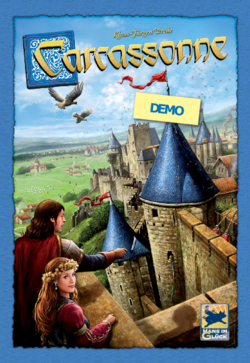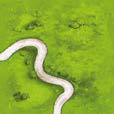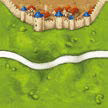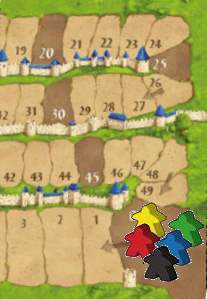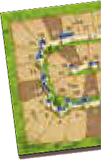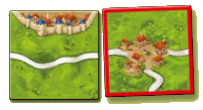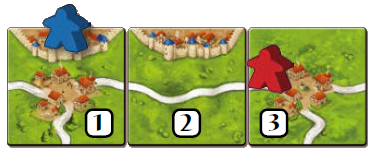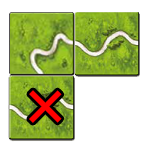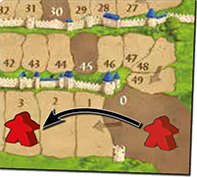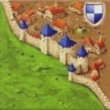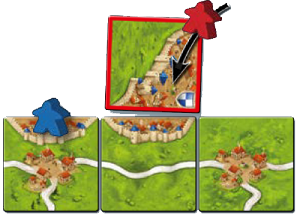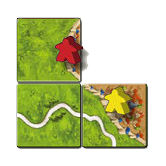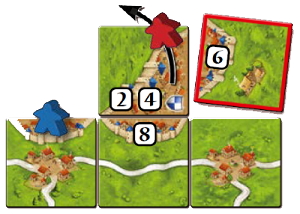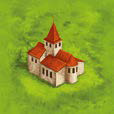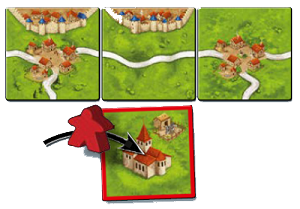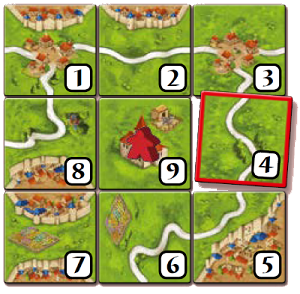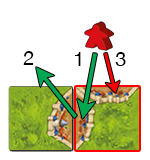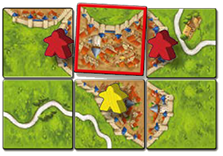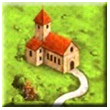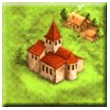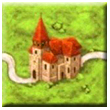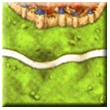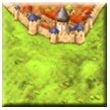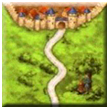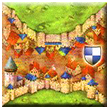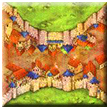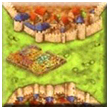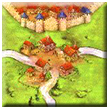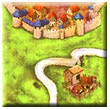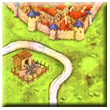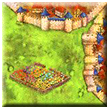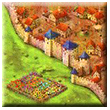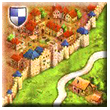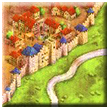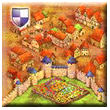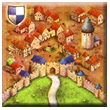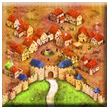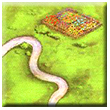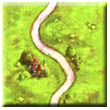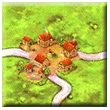Ukázková hra - Tiskni a hraj
Úvod
Následující česká pravidla pro Ukázkovou hru - Tiskni a hraj v edici C2, nemají dosud žádný oficiální překlad do češtiny. Nejnovější pravidla publikovalo vydavatelství HiG v němčině roku 2020 jako součást samostatné hry. Na této stránce je uveden jejich překlad s korekčními úpravami popsanými na souhrnné stránce: ![]() Poznámky k čekému překladu.
Poznámky k čekému překladu.
It is a free print-and-play demo game:
- Print out the tiles included in the PDF rules (see links below) on thick paper, or glue the printouts to cardboard and cut them out carefully.
- You will need different-colored pieces. Each player needs 5 pieces of the same color. The original game contains these little wooden pawn which we call "meeples".
- You can also create a scoreboard (also included in the PDF rules) on which you can display the points during the game. To use this scoreboard, you will need another character in each player color. You can also record your scores on paper.
- This demo game has fewer (48 instead of 72) and smaller tiles. It is also played with fewer meeples (5 instead of 7) than the original Carcassonne. The rules are otherwise the same, and are found below.
- In the basic game there are also rules for advanced players and 2 mini-expansions included.
The tiles and the scoreboard are included in pages 2 to 4 of the rulebook available here:
- English version:
- German version:
The tile distribution is the same as the one for Carcassonne for 2.
Herní materiál a příprava hry
Nejprve je třeba hru připravit, ale to zabere jen okamžik. Během přípravy vás zároveň rovnou seznámíme s obsahem krabice.
There are 48 LAND TILES which depict roads, cities, and monasteries, all of which are generally surrounded by fields.
Every tile shares the same back with the exception of the start tile which you should mark on the back making it easy to set it aside.
Place the start tile (the one you marked) in the middle of the table. Shuffle the remaining tiles and set them as different facedown stacks that are easily accessible to all players. Tiles can also be placed into a sack or game box and drawn randomly.
Then comes the scoreboard, which you set to the side of your playing surface.
Finally, we have the meeples. For this game, you need 5 pieces of the same color for each player. You will also need 1 additional piece for each player, which you place on space 0 of the scoreboard.
| Meeples |
Cíl hry
In Carcassonne, players take turns placing tiles and expanding the landscape of roads, cities, monasteries and fields, one tile at a time. Players may place their meeples on the individual features of tiles as well (roads, cities and monasteries), where they will become highwaymen, knights and monks. Points are earned throughout the game, and the player with the highest score at the end is the winner.
Průběh hry
A game of Carcassonne is played in clockwise order. Starting with the youngest player [1], the current player does the following actions in the order listed below, after which it is the next player’s turn, and so on and so forth. First, we’ll give you a brief description of the actions you have to do during one of your turns. These actions will be detailed as we present the roads, the cities, and finally the monasteries. So what are these actions?
1. Placing a tile
| The player must draw exactly one land tile from a stack and place it faceup adjacent to any tile already on the board to continue the landscape. [2] |
Cesta
1. Placing a tile
You draw the depicted tile with three road segments starting from a village. You must place it in such a way that it continues the existing landscape (the tiles already in play). In the rare case that a tile cannot legally be placed anywhere, and all players agree, it is removed from the game, and the player draws another. [3]
{{RulesPlacingMeeple|title=2. Placing a meeple as highwayman|rules= After placing the tile, you may place a meeple as a highwayman on one of that tile's road segments, but only if the road is not occupied by another highwayman.
Umístění figurky není povinné. Dokud není cesta uzavřena, k žádnému započítání bodů (úkon č. 3, viz podrobně dále) nedojde a na řadě je další hráč.
Další hráč ve svém tahu otočí tuto kartičku a přiloží ji dle obrázku. Na dlouhé obchodní cestě už vpravo stojí družiník červeného, takže sem svého družiníka modrý umístit nemůže, ale mohl by ji umístit jako lupiče na kterýkoli z obou zbylých úseků cesty nově přiložené kartičky. Rozhodne se však umístit družiníka jako rytíře do města (viz dále). Družiníka lze umístit i na území, které bylo přiložením kartičky právě uzavřeno. Kdyby nestál vpravo družiník červeného hráče, mohl by modrý svého lupiče na tuto uzavřenou cestu umístit.
3. Scoring a road
When both ends of a road are closed, that road is completed and scored. The end of a road is closed when it meets a village, [4] a city, a monastery, or it loops onto itself by meeting the other end.
I když červenému dokončil cestu modrý hráč, stále je to cesta červeného a pouze on za ni získá body. Každá kartička, po níž cesta vede, znamená zisk 1 bodu. Protože červený hráč dokončil cestu, která je složena ze 3 kartiček, získá 3 body.
It is now time to note your score. You keep track of your score with the meeple you placed on the scoreboard before starting the game. Continuing our example, you move it forward 3 spaces to show that you've scored 3 points. Note: if your score passes 50 points, lay down your scoring meeple to show your 50+ points.
After each scoring, return to your supply the meeple that was just scored.
Perfektní, již znáte základní pravidla hry a nebylo to složité, že? Nyní tyto úkony dále rozvedeme tím, že vám ukážeme, jak se vztahují k dalším územím, konkrétně k městům a klášterům:
Město
2. Placing a meeple as a knight
Then, you see if there is already a meeple as a knight in the city. Here, there isn’t, so you can place one of your meeples as a knight in this city.
3. Scoring a city
Let's continue our example and assume that a few turns have passed. You now draw this tile that you place to continue your city. Since the tile you’ve placed completes a feature (here, the city), it must now be scored. A city is completed when it is surrounded by walls and there are no gaps inside the city. Since you have a meeple in the completed city, you are the player to score it.
Each tile in a completed city is worth 2 points. In addition, each coat of arms is worth 2 more points. [5] For this city, you score 8 points. As usual, the meeple that was in the scored feature returns to your supply.
Klášter
1. Placing a tile
Once more, you draw a tile to continue the landscape. Monasteries are always depicted in the center of a tile. When placing such a tile, you must, as usual, make sure that it continues the illustration. [6]
3. Scoring a monastery
A monastery is completed when it is surrounded by tiles. During scoring, the monastery is worth 1 point per tile that completes it (including the monastery itself).
By placing this tile, you complete your monastery. It earns you 9 points and allows you to take your meeple back.
Shrnutí
1. Placing a tile
- You must place your drawn tile in such a way that it continues the landscape and the illustration.
- In some very rare cases, it may be impossible to place the tile. In those cases, simply return the tile to the box and draw a new one.
2. Placing a meeple
- You may place a meeple on the tile you’ve just placed.
- You may not place a meeple in a feature where there already is at least one other meeple, including one of yours.
3. Scoring a feature
- A road is completed when both ends lead to a village, a city, a monastery, or the road forms a loop. Each tile in a completed road is worth 1 point.
- A city is completed when it is surrounded by walls and there are no holes inside the city. Each tile in the completed city is worth 2 points. Each coat of arms in the completed city is worth an extra 2 points.
- A monastery is completed when it is surrounded by 8 tiles. Each of the monastery’s tiles (the 8 surrounding tiles and the one with the monastery itself) is worth 1 point.
- Scoring always occurs at the end of a player’s turn. At that moment, each player with a meeple in a scored feature earns points. [7]
- After each scoring, return to your supply the scored meeples.
- If there are multiple meeples in a single scored feature, the player with the most meeples is awarded full points and all other players receive nothing. When more than one player have the most meeples in a scored feature, the tied players all score full points.
Zvláštní případy
Umístění družiníka, započítání bodů a vrácení družiníka v jednom tahu
V rámci jednoho tahu smíte umístit družiníka, započítat si za něj body a opět ho vrátit do své zásoby.
To do so, follow these steps:
__ 1. Právě přiloženou kartičkou uzavřete cestu, město nebo klášter.
__ 2. V rámci pravidel umístíte družiníka na právě uzavřené území.
__ 3. Započítáte si body a družiníka si vezmete zpět do zásoby.
![]() Otázka: There is a situation that puzzles us. If a player draws a tile with two city segments and completes a small city, earning 4 points, can he or she then deploy a meeple to a new city segment in the same turn?
Otázka: There is a situation that puzzles us. If a player draws a tile with two city segments and completes a small city, earning 4 points, can he or she then deploy a meeple to a new city segment in the same turn?
Více družiníků na jedné cestě
Více družiníků v jednom městě

Konec hry a závěrečné vyhodnocení
Bohužel i hra Carcassonne musí jednou skončit… Je to škoda, ale aspoň se dozvíme, kdo vyhrál. Hra končí v okamžiku, kdy hráč na tahu nemůže platně přiložit žádnou kartičku. Poté následuje závěrečné vyhodnocení.
Jakmile skončí hra, započítejte body za neuzavřená území, kde dosud stojí figurky:
- Za cesty získáte po 1 bodu za každou příslušnou kartičku, stejně jako při uzavření cesty.
- Za město získáte za každou kartičku i za každý erb po 1 bodu. Tedy polovinu toho, co během hry.
- Za klášter získáte 1 bod plus po 1 bodu za každou sousedící kartičku.

- Left city: Green is the only one to score 8 points (5 tiles and 3 coat of arms). Black does not score any points since Green has the most meeples in this city.
- Monastery: Yellow scores 4 points for this incomplete monastery (3 points for the adjacent tiles and 1 point for the monastery itself).
- Right city: Blue scores 3 points for this incomplete city (2 tiles and 1 coat of arms).
- Road: Red scores 3 points for this incomplete roads (3 tiles).
Jakmile je závěrečné vyhodnocení u konce, je definitivní konec partie. Vítězem se stává ten hráč, kdo celkově získal nejvíce bodů. Gratulujeme! [8]
Domácí pravidla
- Hráči rozhodnou libovolným způsobem kdo začne hru - například hodem třemi družiníky. Hráč, který jako první „hodí“ stojícího družiníka, rozhoduje o tom, kdo začne hru. (přispěl Joff)
- Určení prvního hráče: každý hráč si vytáhne z pytlíku kartičku a ten který si vytáhl kartičku s největším počtem úseků cest (0 až 4), hraje jako první. Pokud je počet cest nerozhodný, losuje se znovu, dokud někdo nevyhraje. (přispěl michael)
- Další kartičku si hráč vezme ihned po skončení svého tahu, aby měl čas přemýšlet o umístění a vyhnul se analytickému ochromení.
- Hrajte se třemi kartičkami v ruce. Opatství se počítá jako součást vaší zásoby. Zahrajte svůj tah, včetně stavitele a poté si doberte znovu do tří kartiček. Tyto kartičky mohou být pro ostatní hráče viditelné nebo skryté. (přispěl DavidP a youtch)
- Při použití sáčku na kartičky lze do něj vložit i původní startovní kartičku a kartičky které nelze v průběhu hry přiložit, lze také vrátit zpět do sáčku (nikoli že se odloží stranou). (přispěl dwhitworth)
- Pokud je kartička jedinou kartičkou, která může v průběhu hry dokončit území, může ji hráč na tahu ostatním hráčům nabídnout ke „koupi“ tak, že nabídnou body a při „koupi“ si je odečtou, nebo nabídnou opatství atd. (přispěl Deatheux)
- Pokud přiložíte kartičku podle obvyklých pravidel a vyplníte mezeru v krajině, získáte další tah. Tímto jsou hráči motivováni k zaplňování mezer v krajině i když z přiložené kartičky nezískají žádnou výhodu (neplatí pro kartičku opatství). (přispěl viberunner)
- Nedokončené části krajiny na konci hry nepřinášejí žádné body. (přispěl metoth)
- Okraje stolu omezují hrací plochu. Hráč tedy nesmí přiložit kartičku za okraj stolu nebo posunout hrací plochu, aby mohl přiložit kartičku, která by jinak byla mimo okrajem stolu. (Metoth přispěl podnětem a SkullOne upozornil, že se jedná o oficiální pravidlo z Lovců a sběračů.)
- Okraj hrací plochy uzavírá navazující část krajiny, stejně jako opatství. (přispěl PreGy)
- Na počítadle bodů použijte místo počítacího družiníka barevné hrací kostky. Začněte s šestkou nahoře. Když s kodtkou ujedete jedno kolo, otočte ji na číslo 1 (abyste označili, že ujela jedno kolo). Na první pohled tak uvidíte, který hráč má kolik kol a kdo je před kým. Při použití počítadla se 100 políčky je také na první pohled snazší určit něčí počet bodů. (přispěl Carcking)
Seznam kartiček
Poznámky pod čarou
Vysvětlení ikonek najdete na této stránce.
- ↑
 It is common practice to choose starting player at random. More on this in house rules section.
It is common practice to choose starting player at random. More on this in house rules section.
- ↑
 A newly placed land tile must fit the adjacent terrain on all edges! During placement it is not enough to look for only one side that fits.
A newly placed land tile must fit the adjacent terrain on all edges! During placement it is not enough to look for only one side that fits.
- ↑
 If drawing tiles out of a bag, a tile that cannot be placed could be returned to the bag for later use.
If drawing tiles out of a bag, a tile that cannot be placed could be returned to the bag for later use.
- ↑
 Village is a little set of red roofed buildings surrounding the crossroad.
Village is a little set of red roofed buildings surrounding the crossroad.
- ↑
 Note that a coat of arms only affects the city segment it is in, not the whole tile (if there is more than one segment on a single tile).
Note that a coat of arms only affects the city segment it is in, not the whole tile (if there is more than one segment on a single tile).
- ↑
 Monasteries can be placed directly next to each other, or corner to corner. It is not necessary for there to be eight other (non-monastery) tiles neighbouring a monastery. A monastery stands in the middle of a field segment and other segments can be placed next to it. In contrast to roads, cities, and fields, it is not possible to connect to a monastery.
Monasteries can be placed directly next to each other, or corner to corner. It is not necessary for there to be eight other (non-monastery) tiles neighbouring a monastery. A monastery stands in the middle of a field segment and other segments can be placed next to it. In contrast to roads, cities, and fields, it is not possible to connect to a monastery.
- ↑
 When two meeples of one color are occupying the same road or city, you do not score double in these cases. The number of meeples has no effect on the points that a player earns from a road or city. Two knights do not double the points. The number of meeples is only important in establishing who has the majority.
When two meeples of one color are occupying the same road or city, you do not score double in these cases. The number of meeples has no effect on the points that a player earns from a road or city. Two knights do not double the points. The number of meeples is only important in establishing who has the majority.
- ↑
 Pravidla nezahrnují tiebreaky. To jsou pravidla vysvětlující situaci, kdy má několik hráčů stejný počet bodů.
Pravidla nezahrnují tiebreaky. To jsou pravidla vysvětlující situaci, kdy má několik hráčů stejný počet bodů.
